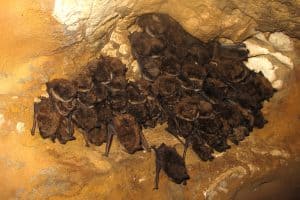Share this article
Alberta bat hibernation site discovered away from mountains
Greg Horne and his fellow cave explorers had just gotten out of a truck from an all-day trip from Edmonton to the northern boreal forest of Alberta, but their journey was far from over.
After the truck ride, they hopped on a helicopter and flew to a remote cave. They had a “spidey sense” it was a hibernaculum for bats, said Horne, the co-coordinator of the Alberta Bat Caver Program with Wildlife Conservation Society Canada. Surrounded by ponds and bogs, the cave is situated in boreal habitat with the potential for plenty of mosquitos and other flying insects for bats to eat during the summer.
“We’d heard about the cave through the Province of Alberta government staff,” Horne said. “Based on my knowledge of other caves in this region and the province father north, I felt there’s potential for this to be another bat cave given similar kinds of geology of bat caves in the region.”
Due to the cold weather, Horne and one other explorer had dressed in dry suits back at the helicopter hanger to prepare for the wet Alberta caves.
The smell of sulfur permeated the low space of air in the cave between the water and the cave ceiling as the two entered. Horne readied himself for the possibility that their hunch was wrong. “You have to be prepared for disappointment,” he said. But they were right. The cave wasn’t didn’t only contain hibernating little brown bats (Myotis lucifugus), but it was the largest known bat hibernaculum in Alberta outside the Rocky Mountains.
On their stomachs, crawling through sulfuric acid water that periodically stung when it splashed into Horne’s and his colleague’s eyes, the team counted the number of bats in the cave. They divided the cave into different zones and kept track of the clusters of bats in the different areas. “One … three … five,” one person would call out, representing the size of the cluster, as the other researcher recorded the numbers.
The team recorded over 200 little brown bats in the cave. They also installed temperature and humidity loggers as they had done in other caves in the past. They found that bats in this cave were showing up in a portion of the cave that was a warmer temperature than usual — 10 degrees Celsius instead of the regional typical cave temperature of 1 or 2 degrees Celsius.
This isn’t good news for the bats as far as white-nose syndrome is concerned, Horne said. Although swabbing the bats turned up no indications of the fungus that causes it, warmer temperatures could mean a more suitable environment for the fungus to grow. And with the fungus having spread from the eastern U.S. to Washington state, devastating bat colonies in the United States and Canada, he worried it could possibly make its way into Alberta.
Horne hopes this new discovery can make it easier to monitor the disease in the area. Now that they know how many bats are in the cave, he said, they can monitor the population and determine if they need to take more swabs to test for the fungus.
Since most hibernacula in the province had only been found in the mountains, Horne said, Alberta officials indicate there may be more caves away from the mountains to investigate for hibernating bats. Along with the WCS Canada Batcaver Program, he hopes to analyze climate information and other data to make a predictive model for which characteristics of caves make them likely candidates for bat hibernacula. He hopes to return to the cave in the summer to fully map the cave and conduct a cave resource inventory.
Header Image: Horne crawls through the Alberta cave in sulfuric acid water in order to count the number of bats in the cave. ©Dave Critchley









